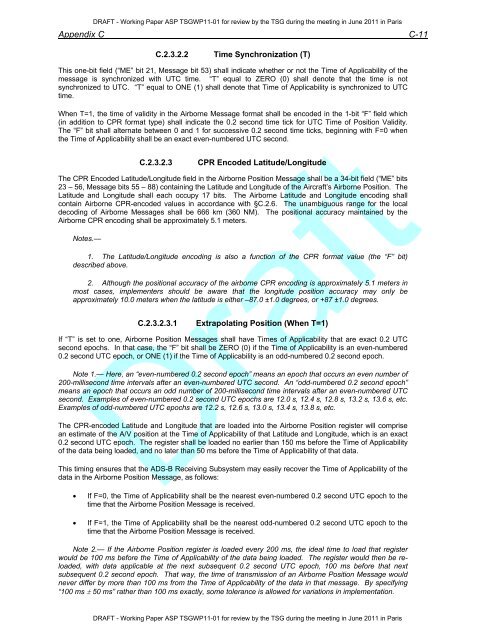Technical Provisions for Mode S Services and Extended Squitter
Technical Provisions for Mode S Services and Extended Squitter
Technical Provisions for Mode S Services and Extended Squitter
You also want an ePaper? Increase the reach of your titles
YUMPU automatically turns print PDFs into web optimized ePapers that Google loves.
Appendix C C-11<br />
C.2.3.2.2 Time Synchronization (T)<br />
This one-bit field (“ME” bit 21, Message bit 53) shall indicate whether or not the Time of Applicability of the<br />
message is synchronized with UTC time. “T” equal to ZERO (0) shall denote that the time is not<br />
synchronized to UTC. “T” equal to ONE (1) shall denote that Time of Applicability is synchronized to UTC<br />
time.<br />
When T=1, the time of validity in the Airborne Message <strong>for</strong>mat shall be encoded in the 1-bit “F” field which<br />
(in addition to CPR <strong>for</strong>mat type) shall indicate the 0.2 second time tick <strong>for</strong> UTC Time of Position Validity.<br />
The “F” bit shall alternate between 0 <strong>and</strong> 1 <strong>for</strong> successive 0.2 second time ticks, beginning with F=0 when<br />
the Time of Applicability shall be an exact even-numbered UTC second.<br />
C.2.3.2.3 CPR Encoded Latitude/Longitude<br />
The CPR Encoded Latitude/Longitude field in the Airborne Position Message shall be a 34-bit field (“ME” bits<br />
23 – 56, Message bits 55 – 88) containing the Latitude <strong>and</strong> Longitude of the Aircraft’s Airborne Position. The<br />
Latitude <strong>and</strong> Longitude shall each occupy 17 bits. The Airborne Latitude <strong>and</strong> Longitude encoding shall<br />
contain Airborne CPR-encoded values in accordance with §C.2.6. The unambiguous range <strong>for</strong> the local<br />
decoding of Airborne Messages shall be 666 km (360 NM). The positional accuracy maintained by the<br />
Airborne CPR encoding shall be approximately 5.1 meters.<br />
Notes.—<br />
DRAFT - Working Paper ASP TSGWP11-01 <strong>for</strong> review by the TSG during the meeting in June 2011 in Paris<br />
1. The Latitude/Longitude encoding is also a function of the CPR <strong>for</strong>mat value (the “F” bit)<br />
described above.<br />
2. Although the positional accuracy of the airborne CPR encoding is approximately 5.1 meters in<br />
most cases, implementers should be aware that the longitude position accuracy may only be<br />
approximately 10.0 meters when the latitude is either –87.0 ±1.0 degrees, or +87 ±1.0 degrees.<br />
C.2.3.2.3.1 Extrapolating Position (When T=1)<br />
If “T” is set to one, Airborne Position Messages shall have Times of Applicability that are exact 0.2 UTC<br />
second epochs. In that case, the “F” bit shall be ZERO (0) if the Time of Applicability is an even-numbered<br />
0.2 second UTC epoch, or ONE (1) if the Time of Applicability is an odd-numbered 0.2 second epoch.<br />
Note 1.— Here, an “even-numbered 0.2 second epoch” means an epoch that occurs an even number of<br />
200-millisecond time intervals after an even-numbered UTC second. An “odd-numbered 0.2 second epoch”<br />
means an epoch that occurs an odd number of 200-millisecond time intervals after an even-numbered UTC<br />
second. Examples of even-numbered 0.2 second UTC epochs are 12.0 s, 12.4 s, 12.8 s, 13.2 s, 13.6 s, etc.<br />
Examples of odd-numbered UTC epochs are 12.2 s, 12.6 s, 13.0 s, 13.4 s, 13.8 s, etc.<br />
Draft<br />
The CPR-encoded Latitude <strong>and</strong> Longitude that are loaded into the Airborne Position register will comprise<br />
an estimate of the A/V position at the Time of Applicability of that Latitude <strong>and</strong> Longitude, which is an exact<br />
0.2 second UTC epoch. The register shall be loaded no earlier than 150 ms be<strong>for</strong>e the Time of Applicability<br />
of the data being loaded, <strong>and</strong> no later than 50 ms be<strong>for</strong>e the Time of Applicability of that data.<br />
This timing ensures that the ADS-B Receiving Subsystem may easily recover the Time of Applicability of the<br />
data in the Airborne Position Message, as follows:<br />
• If F=0, the Time of Applicability shall be the nearest even-numbered 0.2 second UTC epoch to the<br />
time that the Airborne Position Message is received.<br />
• If F=1, the Time of Applicability shall be the nearest odd-numbered 0.2 second UTC epoch to the<br />
time that the Airborne Position Message is received.<br />
Note 2.— If the Airborne Position register is loaded every 200 ms, the ideal time to load that register<br />
would be 100 ms be<strong>for</strong>e the Time of Applicability of the data being loaded. The register would then be reloaded,<br />
with data applicable at the next subsequent 0.2 second UTC epoch, 100 ms be<strong>for</strong>e that next<br />
subsequent 0.2 second epoch. That way, the time of transmission of an Airborne Position Message would<br />
never differ by more than 100 ms from the Time of Applicability of the data in that message. By specifying<br />
“100 ms ± 50 ms” rather than 100 ms exactly, some tolerance is allowed <strong>for</strong> variations in implementation.<br />
DRAFT - Working Paper ASP TSGWP11-01 <strong>for</strong> review by the TSG during the meeting in June 2011 in Paris
















